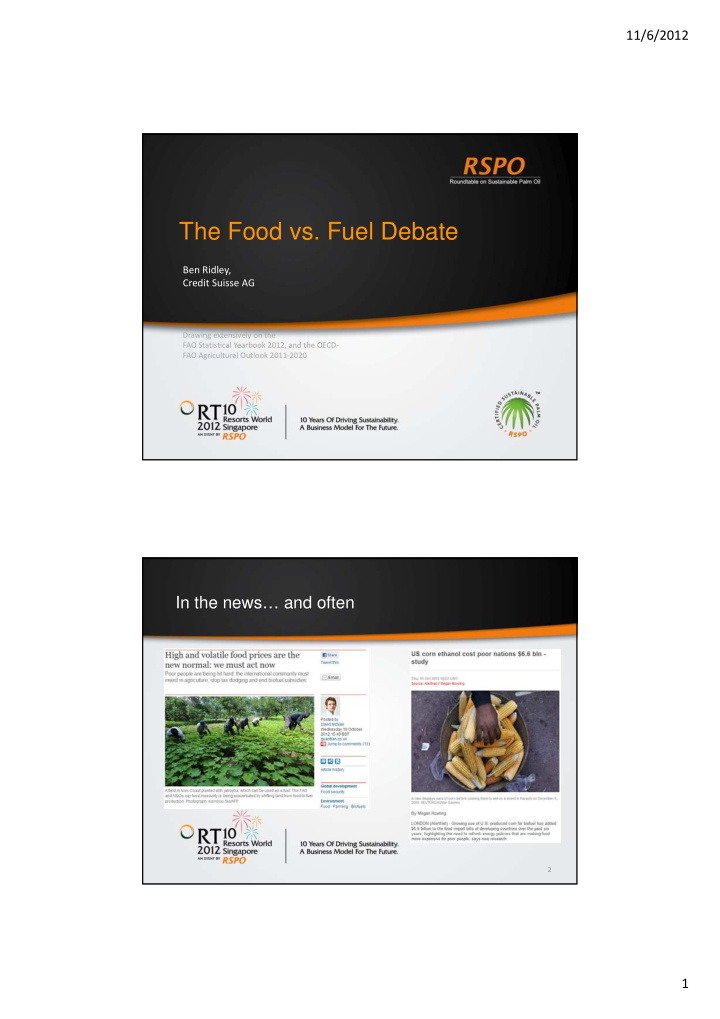



11/6/2012 The Food vs. Fuel Debate Ben Ridley, Credit Suisse AG Drawing extensively on the FAO Statistical Yearbook 2012, and the OECD ‐ FAO Agricultural Outlook 2011 ‐ 2020 In the news… and often 2 1
11/6/2012 Food availability • Population growth – More mouths to feed, mostly in developing countries and in cities • Shifting dietary trends – More protein, more calories • Dietary diversification and adaptation (urban lifestyle > convenience foods) • Vegetable oil a major contributor to increased calorie intake • Do we produce enough food? – Currently, yes – Food distribution is the primary challenge 3 Hunger dimensions • Hunger is a multidimensional phenomenon – poverty and food availability, food access, nutritional balance, etc. • Most food insecurity is in rural South and SE Asia – rural poor tend to be ‘net’ food purchasers – hidden hunger: lack of dietary diversity and poor quality food intake • Significant vulnerability to drought and other disasters – 350 million affected in 2010; mostly in Asia and sub ‐ Saharan Africa – many of those affected already suffering from acute food ‐ insecurity 4 2
11/6/2012 Future food production requirements • Future agricultural production needs a major boost – Production must grow 60% above 2005 ‐ 07 levels to meet 2050 needs • More of the same? – 170% production growth since the 1960s mostly due to increased yield • Intensification at a cost? • The role and significance of new technological applications? • Land availability constraints – 12% of all land areas currently cropped; not many options available • Best expansion prospects in LatAm and sub ‐ Saharan Africa 5 Oilcrops • Steady increase in global demand – Two decades of growth in developed and developing markets • Annual growth of 4.3% compared with 2.3% for all agriculture • 40% of the growth increase due to developing country food demand (e.g., China) • Strong demand for protein rich livestock feed • A handful of crops dominate – 168 million tonnes of oilseeds and oilcrops gathered in 2010 – Oil palm, soybean, rapeseed and sunflower ‐ seed: 75% all production • 40% of supply used in non ‐ food applications, and increasingly biodiesel 6 3
11/6/2012 Oilpalm affordability World prices for selected edible oils Palm oil price trend and forecast Sources: FAO (L) / UNCTAD (R) 7 Oilpalm productivity Oilcrop yields / ha / year (2002 ‐ 2004 ave.) Competitive biodiesel yield Sources: FAO (L) / Lester, 2006 (R) 8 4
11/6/2012 Projected growth in biofuels Trends and forecast in biofuel growth Share of edible oil as biodiesel by country / region 9 Policy developments China 12th Five ‐ Year Plan: goal of utilizing 5 million tonnes of bio ‐ ethanol No promotion of biodiesel | Smallscale biodiesel production (kitchen oil) widespread EU Renewable energy policy: Plans to limit food ‐ based biofuels to 5% of all transport fuel by year 2020 (effectively the same as current usage) India National Biofuel Policy: Indicative target of 20% blending of biofuels by 2017 | Focus on inedible Jatropha oilseed Indonesia Renewable Energy Policy: Raised subsidy for biodiesel manufacturers in 2012 Malaysia Renewable Energy Policy: Implemented mandatory sale of palm oil ‐ based biodiesel (B5) in parts of the country USA Renewable Energy Policy: Determined that palm oil ‐ based biodiesel does not qualify as renewable fuel under US bioenergy policy due to insufficient reduction in GHG emissions 10 5
11/6/2012 A basis for sustainable palm oil biodiesel? • Grow on degraded land – Low conservation value and low carbon stock • Reduce GHG emissions at mills – Methane capture and other technologies • Develop regional export markets (India and China) st and 2 nd generation domestic biofuel developments – Complement 1 * principles: bioenergy production should be… • Comply with BEFSCI – …sustainable and should safeguard and, if possible, foster food security * Bioenergy and Food Security Criteria and Indicators (FAO, 11 6
Recommend
More recommend